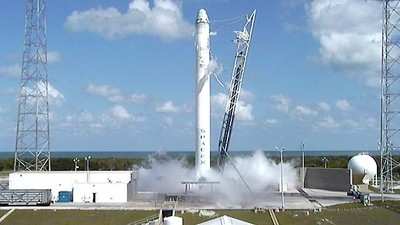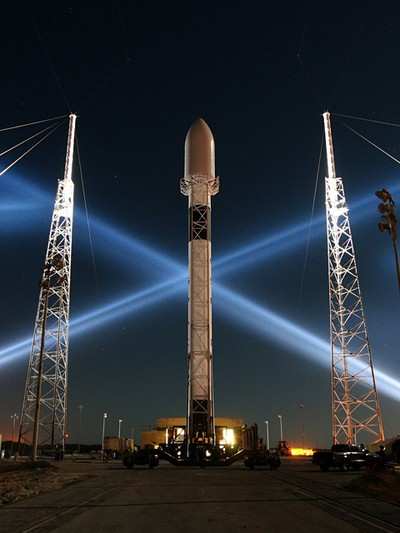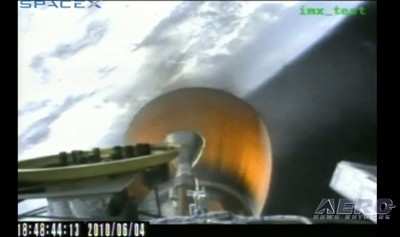Tue, Dec 07, 2010
Falcon 9 Launch Attempt Now Scheduled for Wednesday
Morning
ANN Update 12.07.2010 2016 EST: NASA announced
late Tuesday that the first demonstration flight of SpaceX's Falcon
9 rocket and Dragon capsule for NASA's Commercial Orbital
Transportation Services program has been scheduled for Wednesday,
Dec. 8, from Cape Canaveral Air Force Station in Florida. The
launch window extends from 0900 to 1222 EST.
During a routine inspection this week, SpaceX engineers observed
two small cracks in the rocket's second stage engine nozzle. SpaceX
completed repairs to the cracked nozzle Tuesday.
Original Story: News and Analysis by Wes Oleszewski
Tuesday's planned launching of SpaceX's second Falcon 9 rocket
was scrubbed early Monday. The reason for the scrub was that
engineers discovered two small cracks in the aft end of the 2nd
stage engine nozzle expansion.

The expansion nozzle on the second stage's Merlin engine is made
of a niobium alloy and is used to enhance performance in the vacuum
of space. That enhancement was designed to allow the launch vehicle
to reach the International Space Station (ISS) or to loft heavy
payloads and deep-space vehicles. Since this mission of the Falcon
9 is intended to place the Dragon spacecraft into a simple low
earth orbit that is of a far lower incline that that of the ISS,
the enhancement value of the nozzle is not required. Speculation,
independent of SpaceX, is that if the nozzle extension were to
further fracture after stage separation there would be little
impact on the overall mission.

Although the nozzle extension is nine feet tall and has a base
diameter of eight feet its average wall thickness is less than 1/3
of a millimeter, or slightly thicker than the wall of a soda pop
can. Technicians will be able to use small grinding and cutting
tools to cut away and smooth the damaged areas. The real question
being if the cracks are part of a local anomaly or if they
represent a larger problem.

SpaceX, as of this writing, has elected to announce a final
launch decision on Tuesday evening after greater study of the
issue. If officials are satisfied with the the fixes the Falcon 9
could make a launch attempt as early as Wednesday.
More News
From 2023 (YouTube Version): Legacy of a Titan Robert (Bob) Anderson Hoover was a fighter pilot, test pilot, flight instructor, and air show superstar. More so, Bob Hoover was an i>[...]
Get The Latest in Aviation News NOW on Instagram Are you on Instagram yet? It's been around for a few years, quietly picking up traction mostly thanks to everybody's new obsession >[...]
Aero Linx: B-52H Stratofortress The B-52H Stratofortress is a long-range, heavy bomber that can perform a variety of missions. The bomber is capable of flying at high subsonic spee>[...]
Altimeter Setting The barometric pressure reading used to adjust a pressure altimeter for variations in existing atmospheric pressure or to the standard altimeter setting (29.92).>[...]
"Knowing that we play an active part in bettering people's lives is extremely rewarding. My team and I are very thankful for the opportunity to be here and to help in any way we ca>[...]
 Classic Aero-TV: Remembering Bob Hoover
Classic Aero-TV: Remembering Bob Hoover ANN FAQ: Follow Us On Instagram!
ANN FAQ: Follow Us On Instagram! ANN's Daily Aero-Linx (05.15.24)
ANN's Daily Aero-Linx (05.15.24) ANN's Daily Aero-Term (05.15.24):Altimeter Setting
ANN's Daily Aero-Term (05.15.24):Altimeter Setting Aero-News: Quote of the Day (05.16.24)
Aero-News: Quote of the Day (05.16.24)





